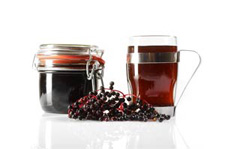Elderberry Juice

Elderberry Juice: Uses, Dangers and How To’s
Elderberry juice is high in vitamins and nutrients and can be a great way to enrich your diet and fight diseases, including cancer. But, like many so-called super fruits, there are warnings out there about the dangers of using elderberries in a regular diet. Obviously, these proclamations must be considered on a personal level, and many nutritionists still highly recommend the tasty juice of the elderberry as part of a healthy diet.
First, the Good News
The good news about elderberry juice is that it is highly nutritious. Elderberries are rich in vitamin C, so they can be used to ward off a cold or sooth its symptoms. There are also antioxidant properties found in elderberries, which is why this type of juice can be added to a diet focused on preventing cancer.
Some nutritionists use elderberries to fight off a fever, because the juice of this berry is known to encourage the body to sweat. These berries are also reported to have some mild laxative properties as well as acting like a diuretic. While a portion of two of this juice is wonderful, try not to overdo it – at least at first – to make sure these healthy effects are not turned into a bit of a problem.
Take the Bad News With the Good
Elderberries have been around for ages, and their medicinal qualities have quite a long history. There are also a few warning to heed, however, especially when picking these berries on your own. Elderberries must be fully ripened before they are consumed, because they contain some poisonous compounds when they are not totally ripe. While the poisons contained in unripe elderberries are not deadly in small doses, they taste very better and should never be eaten or made into juice until they are fully ready.
The other major concern that comes with the elderberry is their stems, which can contain the same poisons that are found in unripe elderberries. Whenever you prepare elderberries for juicing or any other form of consumption, be sure to completely remove all stems and leaves. Then make sure the berries are fully ripe and cleanse them thoroughly before use.
If picking elderberries on your own, be sure to have a reliable identification guide to make certain that you are in fact picking elderberries. This type of berry is similar in appearance to both poke berries and poison ivy berries, two kinds of berries that are unfortunately toxic. It may be the best idea to purchase elderberries at a local produce market to refrain from making any detrimental identification errors.
How to Prepare Elderberry Juice
The first step in preparing the juice is to pick or purchase your elderberries. Once you get them home, sort through them carefully to make sure there are no stems remaining. Then wash the berries thoroughly in warm or cool water.
Next fill a non-reactive pot with water and add the elderberries. Allow the berries to come to a complete boil, but do not allow them to boil over. Once the water boils, remove the pot from the heat and cover it. Now simply let the berries stand in the water over night.
The next morning, remove the berries from the water and pass them through a mesh sieve in order to strain off the juice. To make sure you get all of the juice out of your berries, put the strained berries into an old (but clean!) kitchen towel and squeeze out any remaining juice. After you have squeezed all of the juice out of the berries, throw away whatever berries are left.